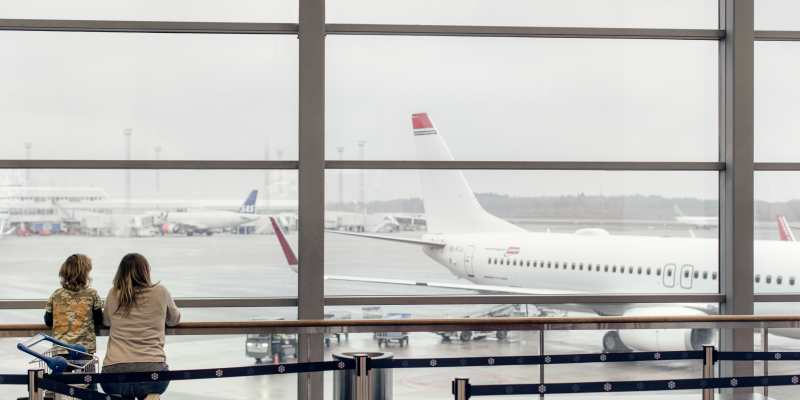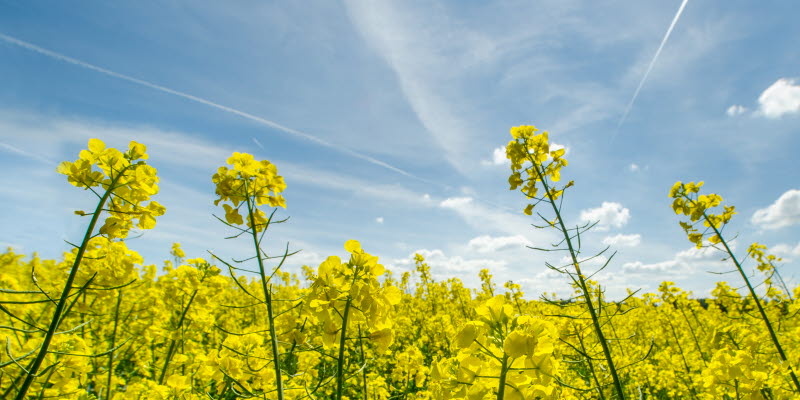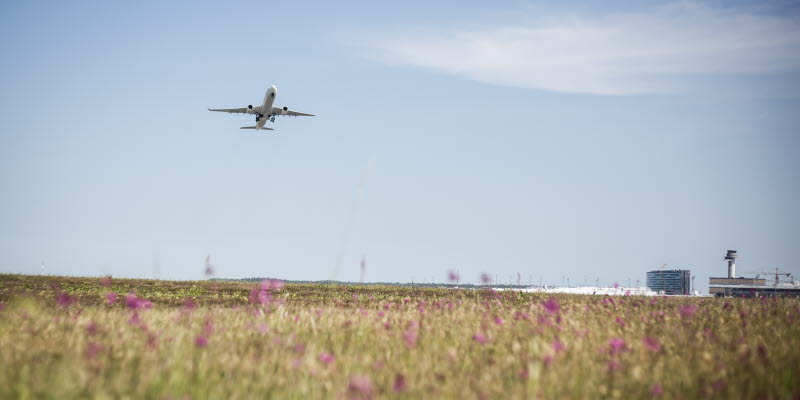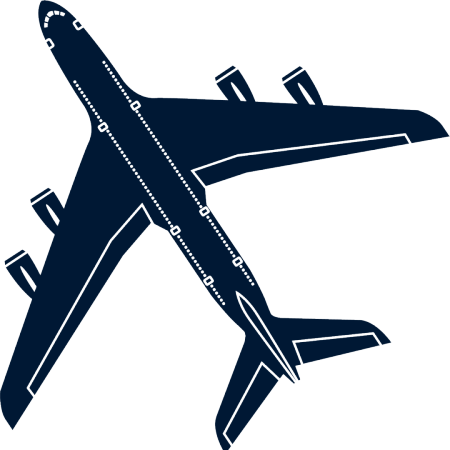Environment
Environmental issues are a priority at Swedavia, and Stockholm Arlanda Airport works continuously in a number of different areas to reduce its environmental impact.
Swedavia's climate work

Our zero vision
In 2020, Swedavia achieved the company’s goal of no fossil carbon dioxide emissions from airport operations run under our own management.
Extensive work underpins our success in achieving zero fossil carbon dioxide emissions. We purchase green electricity for all our operations, the back-up power supply runs on hydrotreated vegetable oil (HVO), our vehicle fleet runs on HVO, fossil-free gas or green electricity, and we purchase liquefied petroleum gas (biogasol) and biogas.
Expanded climate work
All of Swedavia’s airports are accredited at the ACA 3+ level in accordance with Airport Council International (ACI) Europe’s standards for the climate work of airports. That means our airports continuously reduce fossil carbon dioxide emissions from their own operations, offset the emissions that have not yet been reduced and help other businesses operating at the airports to reduce their emissions. At the end of 2020, we achieved our fossil carbon dioxide emissions goal for airport operations run under our own management.
The next goal is to have all the airports accredited at the ACA 4+ level, which means that compounds to de-ice runways/aircraft and coolants are to be included in the measurements. We shall also work to a greater extent to engage and work together with other companies and organisations that have significant carbon dioxide emissions at the airports in order to continue reducing emissions together. Over time, all the operations at our airports will switch to renewable energy sources. This work is in line with the International Panel on Climate Change’s goal not to exceed a 1.5 degree rise in global warming as well as Swedavia’s strategy and goals for proactive climate change adaptation.
Facts about Airport Carbon Accreditation (ACA)
- Airport Carbon Accreditation is a framework within Airport Council International (ACI) which evaluates airports' work with handling and reducing their carbon dioxide emissions. The framework has six levels.
- The set certification requirements for ACA4+ includes adapting the airport's handling of carbon dioxide to the Paris Agreement as well as an inclusion of further emission sources in the airport's climate footprint that covers all considerable operational emissions from a third party. The emphasis is on creating effective partnerships with airport actors to reduce emissions. The initiated partnership plan that contributes to the change for the airport's partners as well is a prerequisite for the certification.
- Six of Swedavia's ten airports have been certified at the highest level, ACA4+; Stockholm Arlanda Airport, Göteborg Landvetter Airport, Malmö Airport, Åre Östersund Airport, Visby Airport and Kiruna Airport. The four remaining airports - Bromma Stockholm Airport, Luleå Airport, Umeå Airport and Ronneby Airport - will be certified according to ACA4+ during 2023 and 2024.
- Stockholm Arlanda Airport was one of 17 airports that joined the framework at its start in 2009. Göteborg Landvetter Airport joined in 2010. Both airports were immediatly put in the, then, highest level of the framework, ACA3+ and Swedavia became the first airport concern in the world to become fossil free in their own operation at the end of 2020. Stockholm Arlanda Airport also became the first airport to accept ACI's newly constituted ECO Innovation Award in 2010, a distinction the airport also received in 2021.
Green Flyway is a project to create an international testing arena for electric and autonomous aircraft in Östersund and Röros connected to an airspace corridor between Trondheim, Röros and Östersund.
The project was launched on October 1, 2020, making Åre Östersund Airport the first of Swedavia’s ten airports to test and prepare infrastructure enabling the transition to increased electrification of aviation. The test centre enables the testing of electric aircraft and drones under the scope of the EU/interregional project Green Flyway. The goals of the project are also to investigate airspace control for autonomous aircraft, adapt airports to electric operations, work to develop electric air routes and spread knowledge and skills.
Environmental impact

The environmental impact of aviation is crucial to the aviation industry and thus to the airport. We therefore continually strive to decrease the negative environmental impact from the airport, primarily by reducing greenhouse gas emissions, reducing other atmospheric emissions and discharges to water, and minimising the use of chemicals and the generation of waste.
Biodiversity
High nature conservation values
There are areas with very high nature conservation values in the vicinity of the airport. Two species on the EU Red List of threatened species, three protected species and two so-called indicator species have been found. The relatively rare field gentian (Gentianella campestris ssp. fennica) is found in very large quantities in the airport area. These species thrive here thanks to the airport’s management of its land. Regular cutting of the airport’s grasslands creates carefully maintained grasslands, a relatively uncommon type of natural landscape today. To preserve biodiversity, it is obviously important to continue management of the grasslands at the airport.
The Green Oasis
Some of the unique species found at the airport are presented in Åre Österlund’s “green oasis,” a mini park located at the airport. Visitors can enjoy a quiet moment in a beautiful setting, one that also provides information about biodiversity and other aspects.
Lövtorpsbäcken
Environmental project - filming of fish
Åre Östersund Airport studies the population of grayling (Thymallus thymallus) in the Lövtorpsbäcken river to determine whether the fish are affected by the airport’s discharges to water. The grayling are filmed at a minimum every five years and are counted when they swim up the river during the spawning season. The grayling can be studied by catching them, but in that case it is easy for them to be injured. To map and study the population, Swedavia has instead developed a method together with experts which entails the filming of grayling as they swim up the Lövtorpsbäcken river to spawn during the month of May.
Good conditions for grayling
The surveys have shown that the physical and physicochemical conditions for grayling reproduction are very good in the Lövtorpsbäcken river. This means among other things that the flow is strong enough, there is enough water at the time the grayling spawn and it has the right light conditions, enough trees around the river, the right kind of material on the river bottom, the right water quality and the right food for the species.
Environmental permit
In the autumn of 2006, a new environmental permit procedure for Åre Östersund Airport was launched. An application for a new permit was submitted to the Environmental Court in September 2007. In November 2008, the Environmental Court in Östersund issued a new permit. This was appealed in the Environmental Court of Appeals, which issued a ruling in November 2009. After another appeal was filed, the Swedish Supreme Court ruled not to issue a leave to appeal and the previous rulings were upheld.
Read more here:
Environmental Court’s ruling (in Swedish)
Environmental Court of Appeal’s ruling (in Swedish)
Environmental permit procedure (in Swedish)
Environmental management system
The airport is certified for its environmental performance in accordance with ISO 14 001 standards. This certification indicates that the airport not only complies with the requirements of environmental authorities but also with the general and specific environmental goals set for Åre Östersund Airport. Both internal and external environmental audits are carried out at the airport. The aim of these audits is to check whether the environmental management system is used, is sufficient and is effective. There is continuous improvement work under way, with increasingly stringent requirements, which means environmental goals are also raised every year.
Environmental reporting
The environmental report must show how these operations comply with the conditions set. It is also good for self-inspection and gives the regulatory authority a documentary basis for its oversight. The report must be sent to the regulatory authority by March 31 of the following year. Operations at Åre Östersund Airport are subject to an environmental permit, and the airport submits its report to the Jämtland County Administrative Board.
Environmental report 2021 (pdf, in Swedish)
Appendix 1 – List of vehicles (pdf, in Swedish)
Appendix 2 – Sampling points (pdf, in Swedish)
Appendix 3 – Coolant report (pdf, in Swedish)
Appendix 4 - Waste (pdf, in Swedish)
Purpose and objectives
Swedavia owns, operates and develops airports and properties near these airports in Sweden. We strive to continuously improve our management system (ISO 14001) to minimize our environmental impact and use resources in a sustainable manner throughout the value chain. This is done
primarily by reducing greenhouse gas emissions, minimizing other atmospheric emissions and discharges to soil and water and minimizing the use of harmful chemicals. We shall even secure effective management of resources in order to contribute to circular economy and continuously work
to improve energy efficiency.
For us, it is a given that we comply with environmental and energy statutes in effect as well as other applicable national and international regulations and requirements. It is also a given that we ensure access to the information and resources required to achieve our environmental and energy objectives
and targets. We shall also work to limit aircraft noise and emissions from aircraft operations.
In order to achieve this, working in accordance with the following
fundamental rules is required:
- Environmental concern is integral to every part of operations and is taken into consideration in every decision.
- The most important environmental issue for the aviation and real estate sectors is their climate impact, and this must be given priority in decisions and activities.
- We shall continuously improve energy efficiency and manage our own operations as well as influence other companies and organizations that we interact with for the sustainable use of resources.
- We shall purchase energy-efficient products and services and promote construction that leads to better energy performance.
- All of Swedavia's employees shall take part in our environmental and energy work.
- We shall assess and manage environmental risks and energy performance in a systematic manner.
- Swedavia shall take an active part in local, regional, national and international work in order to reduce the aviation industry's negative impact on the environment and work for the sustainable development of airports.
Track flights

One public tool available for use is Flightradar24.com.
The Webtrak tool that we previously made available here on our website is being reviewed, and we are exploring the possibilities of using other data sources. This is in order to once again enable people living in the vicinity of our airports to track air traffic movements and link this information to aviation noise measurements where available.
